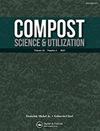Transformations of Phosphorus and Other Plant Nutrients in Poultry Litter Composted with Sugarcane and Cabbage Wastes
IF 0.9
4区 农林科学
Q3 ECOLOGY
引用次数: 5
Abstract
ABSTRACT Poultry litter (PL) is a significant source of nutrients, but a suitable amount of carbon needs to be added as a bulking agent during its composting to a stable nutrient source. Here, we characterized the transformation of phosphorus and other plant nutrients during aerobic composting of PL with sugarcane (SW) and cabbage waste (CW) for 120 d. Periodic samples were collected during composting and analyzed for total C, P (and its fractions), K, Ca, Mg, Cu, Fe, Zn, Mn, EC and pH. At the initial stage of composting (20 d), the P fractions varied in the order: water soluble P > NaHCO3-P (readily plant-available) > HCl-P (Ca+Mg-bound) > residual-P > NaOH-P (Fe+Al-bound). After 120 d, the order was HCl-P > residual-P > water-P > NaHCO3-P > NaOH-P. These variations suggested a transformation of labile Pi to more recalcitrant forms during composting. Water soluble P was the dominant fraction during the initial composting period. This declined progressively with time of composting, while the HCl-P increased, confirming the transformation of the more vulnerable water soluble P to the more recalcitrant HCl-extractable P. This indicated that the composting could be a useful way of managing manure for P stabilization and reducing its losses in runoff water following land application. The total C varied directly with the ratio of sugarcane and cabbage wastes in the manure but was inversely related to the duration of composting. Extractable K, Ca, Mg, and Na increased whereas trace elements concentrations decreased with time of composting. The higher availability of basic plant nutrients and reduced availability of heavy metals in the mature compost are valuable attributes for safe use in sustainable agricultural production.甘蔗、白菜废弃物堆肥禽肉中磷及其他植物养分的转化
摘要家禽粪便(PL)是一种重要的营养来源,但在堆肥过程中需要添加适量的碳作为填充剂,以获得稳定的营养来源。在这里,我们表征了PL与甘蔗(SW)和卷心菜废料(CW)的好氧堆肥120 d期间磷和其他植物营养素的转化。在堆肥过程中定期收集样品,并分析总C、P(及其组分)、K、Ca、Mg、Cu、Fe、Zn、Mn、EC和pH。在堆肥的初始阶段(20 d),P组分的变化顺序为:水溶性P>NaHCO3-P(易于植物获得)>HCl-P(Ca+Mg结合)>残留物P>NaOH-P(Fe+Al结合)。120d后,其顺序为HCl-P>残留物P>水P>NaHCO3-P>NaOH-P。这些变化表明,在堆肥过程中,不稳定的Pi转化为更难降解的形式。在堆肥初期,水溶性磷是主要成分。随着堆肥时间的推移,这一比例逐渐下降,而HCl-P增加,证实了更脆弱的水溶性P转化为更难分解的HCl可提取P。这表明堆肥可能是管理肥料稳定磷和减少其在土地施用后径流中损失的一种有用方法。总碳含量与肥料中甘蔗和卷心菜废弃物的比例直接相关,但与堆肥时间呈负相关。随着堆肥时间的延长,可提取的K、Ca、Mg和Na含量增加,而微量元素浓度降低。成熟堆肥中基本植物营养物质的可用性较高,重金属的可用性较低,这是可持续农业生产中安全使用的宝贵属性。
本文章由计算机程序翻译,如有差异,请以英文原文为准。
求助全文
约1分钟内获得全文
求助全文
来源期刊

Compost Science & Utilization
农林科学-生态学
CiteScore
4.10
自引率
0.00%
发文量
0
审稿时长
>36 weeks
期刊介绍:
4 issues per year
Compost Science & Utilization is currently abstracted/indexed in: CABI Agriculture & Environment Abstracts, CSA Biotechnology and Environmental Engineering Abstracts, EBSCOhost Abstracts, Elsevier Compendex and GEOBASE Abstracts, PubMed, ProQuest Science Abstracts, and Thomson Reuters Biological Abstracts and Science Citation Index
 求助内容:
求助内容: 应助结果提醒方式:
应助结果提醒方式:


